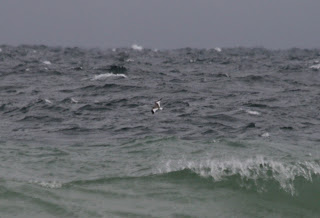 |
| Thayer's Gull |
In an ironic twist of fate the weather man was correct in his predictions for the past few days but Mother Nature simply wasn't listening as favorable weather for migration has been largely free of our feathered friends. Of course there are always a few birds with an average of about 1500 per day but with the light-strong western and northern winds that have been present since the 14th it seems like a let down more than anything. The forecast continues to be promising though so hopefully we can get on the right track soon and have a little more to be excited about.
Overall duck diversity is still pretty good with an increase in dabbler numbers over the past few days while the expected divers continue to be seen. A surge of
Gadwalls,
American Black Ducks, and
Northern Pintails over the past few days has been a welcome sight while decent numbers of
American Wigeons,
Mallards, and
Green-winged Teals have also been noted, 3 late
Northern Shovelers were seen on the 16th. There were decent numbers of
Aythya ducks on the 14th but since then they have been in short supply with small numbers of
Redheads,
Ring-necked Ducks, and
Lesser Scaup joining the flocks of
Greater Scaup. The best duck of late was the third
Harlequin Duck of the season which was noted with two Surf Scoters on the 15th while overall scoter numbers have been good with daily high counts of 28
Surfs on the 14th, 320
White-wingeds on the 14th, and 13
Blacks on the 15th. "Winter" ducks are beginning to increase as well with small numbers of
Buffleheads and
Common Goldeneyes showing up more frequently in recent days while
Long-tailed Duck numbers are steadily increasing as one would expect.
Loon numbers are holding steady with a daily average of more than 50
Commons from the 14th to the 17th while up to 5
Red-throateds continue to be seen daily. Grebe numbers have also held their own with about 20
Horneds per day lately while
Red-neckeds continue to add to the record high count at a rate of nearly 90 each day. As is customary this time of year shorebirds have been very few and far between with a group of 4
Dunlin on the 15th being the only birds seen other than an occasional
Sanderling. The juvenile
Sabine's Gull first noted on the 13th was still being seen regularly each day through the 17th with a second migratory bird noted on the 15th. The season count now stands at 17, just two short of the all-time season record. The only large white-headed gull noted beyond the two ubiquitous species was a 1st-winter
Thayer's that was found among the the roosting gulls on the point late this afternoon.
It's the season of sparse landbirds so this weekend's low numbers were no surprise but there were a few nice birds noted with a
Townsend's Solitaire seen at the edge of the Jack Pines on the morning of the 17th being the best. Other good birds noted included a
Sharp-tailed Grouse that was found along the trail to the point on the 16th, a
Short-eared Owl that came across the lake on the morning of the 17th, and a
Brown Thrasher frequenting the feeders during the afternoon of the 17th. Other birds seen of late included a few lingering warblers (mainly
Yellow-rumped) and a lone
Blue-gray Gnatcatcher while winter finches (including
Common Redpoll and
Evening Grosbeak) and
Snow Bunting numbers continue to increase with each day that passes. Raptor numbers have been good lately with the increased
Buteo migration in recent days totaling about 15
Rough-leggeds and 25
Red-taileds while
Bald Eagle,
Northern Harrrier,
Northern Goshawk,
Merlin, and
Peregrine Falcon have also been seen coming in across the lake or hunting the point.









.JPG)



